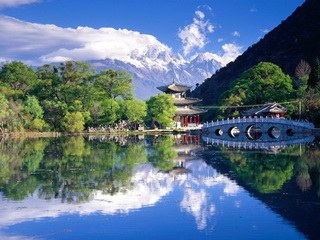
 China Tours
China Tours Tibet Tours
Tibet Tours China Theme Tours
China Theme Tours Off The Beaten Track
Off The Beaten Track Yangtze Cruises
Yangtze Cruises China Trip Planner
China Trip Planner Travel Agents
Travel Agents


We had a wonderful time in Tibet. We have learned a lot about this unique destination because of the wonderful guide Degyi who is so knowledge and always available towards our tours. We stayed at the Shangri-La Hotel Lhasa, and we would never imagine a Tibet travel could be so nice and amazing without the help of Degyi.
Also, thanks a lot to our Tibetan driver Mr.Wongdun for his safe driving and a good sense of service along the way.
We shall return Tibet in the near future!
P.B. and A. A - Europe
Tibet Travel
June 2018 (Private Tibet Journey from Kathmandu)

 Modern tourism in China sprang up in the early 1950s. In 1954, the China International Travel Service was established, with 14 branches in Guangzhou, Shanghai, Beijing and other major cities. In 1964, the State Tourism Administration of China was formally established. Since the initiation of the policies of reform and opening to the outside world in 1978, China's tourism has entered a stage of rapid development. In 1999, the number of tourists entering China reached 72.8 million, of which 8.43 million were foreign tourists, 40 times the figure for 1978. Consequently, the foreign exchange income from this industry reached US$14.1 billion, 54 times that of 1978.
Modern tourism in China sprang up in the early 1950s. In 1954, the China International Travel Service was established, with 14 branches in Guangzhou, Shanghai, Beijing and other major cities. In 1964, the State Tourism Administration of China was formally established. Since the initiation of the policies of reform and opening to the outside world in 1978, China's tourism has entered a stage of rapid development. In 1999, the number of tourists entering China reached 72.8 million, of which 8.43 million were foreign tourists, 40 times the figure for 1978. Consequently, the foreign exchange income from this industry reached US$14.1 billion, 54 times that of 1978. Currently, China has become an important tourism destination in Asia, and the fifth large tourism country in the world. Domestic tourism is also growing vigorously. In 1999, the number of domestic tourists reached 719 million, spending a total of 283.2 billion yuan-14.3 percent and 105.9 percent increases over 1995, respectively. With the improvement of the Chinese people's living standards, Chinese citizens have an increasingly strong interest in traveling abroad. In recent years, Chinese citizens have traveled to Southeast Asia and Europe. Foreign travel agencies are now opening offices in China to attract Chinese to travel abroad.
Now, China is fast on its way to becoming a country with developed tourism, and constantly improving tourism facilities and services. It is estimated that, by 2020, China will be the world's No. 1 tourism destination and the fourth-largest nation of tourists.
Tourist resources in China can be divided into three main groups: natural sites, historical and cultural sites and folk customs.
China natural sites include China's stunning mountains, lakes, valleys, caves and waterfalls. Mount Taishan in the east, Mount Hengshan in the south, Mount Huashan in the west, Mount Hengshan in the north, and Mount Songshan in the center of China have been called the Five Sacred Mountains since antiquity. Mount Taishan, which snakes through central Shandong Province, is admired by Chinese as paramount among them. Another mountain celebrated for its beauty is Mount Huangshan in southern Anhui Province, known for its graceful pines, unusual rocks, cloud seas and hot springs.
Jiuzhaigou, Huangguoshu Waterfalls, and Guilin are all located in southwestern China. Jiuzhaigou in northern Sichuan Province is a beautiful "fairyland valley" running over 40 km through snow-covered mountains, lakes, waterfalls, and forest. The Huangguoshu Waterfalls in Guizhou Province are a group of waterfalls, 18 above-ground and four below, which can be heard from five km away. The Lijiang River in Guangxi Zhuang Autonomous Region winds its way through karst peaks for 82 km between Guilin and Yangshuo.
On the plateau in northern China are many spectacular lakes. The Tianchi (Heavenly Pool) in the Tianshan Mountains in Xinjiang Autonomous Region is 1,980 meters above sea level. This 105-m-deep lake is crystal clear, the high mountains surrounding it carpeted with green grass and colorful flowers. Along the renowned Three Gorges of the Yangtze River are many scenic spots and historical sites; the Qutang Gorge is rugged and majestic, the Wuxia Gorge elegant, deep and secluded, the Xiling Gorge full of shoals and reefs and rolling water. The Lesser Three Gorges are lush with greenery, flanking water so clear you can see to the bottom. The Three Gorges Dam built here is China's biggest key hydro-power project.
China's long history has left many cultural relics and the title of "China Top Tourist City" has gone to the first group of 54 cities. The Great Wall of China, a symbol of the Chinese nation, is also a prime example of historical sites that have become major tourist attractions. As the greatest defense-structure project in the history of human civilization, it dates back more than 2,000 years ago to the Spring and Autumn and the Warring States periods - huge in its scale and grandeur, it rates as a world wonder. Grottoes filled with precious murals and sculptures are concentrated along the ancient Silk Road in Gansu Province. The best known are the Mogao Caves, a "treasure house of oriental art," with 492 caves with murals and statues on the cliff faces. In the south, grotto art is represented in Sichuan Province by the Leshan Giant Buddha, carved into a cliff face. Seventy-one meters high and 28 meters wide, it is the largest sitting Buddha in stone, showing the superb carving skill of ancient craftsmen.
The Shaolin Temple in Henan Province, the birthplace of Chinese Zen Buddhism and famous for its Shaolin kungfu martial arts, dates back to 495 A. D. Here can be seen the Ming period Five-Hundred-Arhats Mural and Qing period Shaolin kungfu paintings. In western Sichuan Province, Mount Emei, dotted with ancient Buddhist temples and structures, is one of China's four holy Buddhist mountains.
Most of China's 101 cities classified as famous historical and cultural cities are over 1,000 years old. South of the Yangtze River, Suzhou and Hangzhou, long known as "paradise on earth," are crisscrossed with rivers, lakes, bridges, fields and villages, as beautiful as paintings. Today's well-preserved ancient city of Pingyao in central Shanxi Province was built in the Ming Dynasty but was also the site of the Neolithic era Yangshao and Longshan cultures, 5,000 to 6,000 years ago. Ancient Lijiang in Yunnan Province is not only the center of Dongba culture of the Naxi ethnic group but also a meeting place for the cultures of Han, Tibetan and Bai ethnicities.
The diverse cultures and life-styles of China's 56 ethnic groups are reflected in their festivals. The biggest Tibetan festival - Shoton (Yogurt) Festival - is also the setting for the Tibetan Theatrical Festival, when for five days every summer Tibetan theatrical groups perform and compete in the summer palace of the Dalai Lamas. Another summer festival is the Nadam Fair in the Mongolian grasslands, where attractions include wrestling, horse racing and archery competitions.
"March Street" celebrated by the Bai people in Dali, Yunnan Province, is associated with the Buddhist Goddess of Mercy suppressing a devil to help the Bai people. It became traditional to burn incense and offer sacrifices to commemorate her virtues every year and the festival has become a major annual gathering for Bai commercial, cultural and sports activities.
The Water-Sprinkling Festival of the Dai ethnic group in Xishuangbanna, Yunnan Province, is a lively occasion taking place in the spring. People chase and pour water (a symbol of good luck and happiness) over each other, among other activities such as dragon boat racing and peacock dance.
Lugu Lake between Sichuan and Yunnan provinces has become a tourist destination following the building of a new highway giving access to this area. The matriarchal society of the 30,000 local Mosuo people is noted for its "no marriage" traditions and is called the last women's kingdom on the earth. Mosuo women, local dugout canoes and undulating singing style are considered unique to Lugu Lake.
Chinese music, dance and opera, and the culture and customs of ethnic minorities are treasure stores of tourism resources. Coming to China, tourists appreciate folk art, including uniquely charming Peking Opera performances and comic dialogues, and also learn about ethnic customs such as the Dai Water Sprinkling Festival, Yi Torch Festival, Bai March Street, Zhuang Singing Festival and Mongolian Nadam Fair. Besides, tasting Chinese cuisine is an absolutely necessary part of touring in China. The Beijing Roast Duck of the Quanjude Restaurant, Mongolian boiled mutton, Guangdong's roasted piglet, Hangzhou's West Lake vinegar fish, Sichuan's spicy bean curd and a variety of local-flavor snacks are only some of China's culinary delights.
China Trip Planner | Travel Agents | About Us | Why Us | Contact Us | How to Pay | How to Book - Terms & Conditions | Site Map
Copyright © 2010 - 2030 All Rights Reserved.


 0086-28-85711328
0086-28-85711328 0086-28-85546015
0086-28-85546015




